
Ms. Dhruti Sanghvi, Post Graduate Academic Scholar in Fashion Management, National Institute of Fashion Technology, Ministry of Textiles, Daman campus

Dr Vidhu Sekhar P, Assistant Professor, Department of Fashion Management Studies, National Institute of Fashion Technology, Ministry of Textiles, Daman campus
Introduction
The global apparel and textile industry operates within an oligopolistic market structure dominated by a few key players. Leading producers and exporters include China, India, Bangladesh, the USA, and the European Union. This report examines the major forces shaping the industry, including sustainability regulations, trade conflicts, geopolitical issues, and technological advancements. Additionally, the report highlights future trends and strategic recommendations for businesses to stay competitive in this evolving landscape.
Major Players & Market Share
The global apparel and textile industry is an oligopoly, dominated by major players like China, India, Bangladesh, the USA, and the EU. China is the largest producer and exporter, benefiting from economies of scale, automation, and a strong supply chain, though it faces rising labour costs and trade restrictions. India is a key producer of cotton, handlooms, and sustainable textiles, leveraging skilled labour and a strong domestic market, but struggles with infrastructure challenges and competition from China. Bangladesh, the second-largest apparel exporter, enjoys low labour costs but is hindered by poor working conditions and heavy reliance on EU and US markets. The USA is a significant importer and high-end apparel producer, known for its advanced technology and premium brands, but faces stiff competition from Asia and pressures to reshore manufacturing. The EU is recognized for its sustainable fashion focus and eco-conscious consumers, but high labour costs and competition from fast fashion remain challenges.
Changing Scenario Due to Global Issues
Environmental Factors & Sustainability Trends
Increasing concerns about sustainability have resulted in stricter regulations and shifts in consumer behavior. Governments and businesses are focusing on sustainable sourcing, ethical labor practices, and reducing carbon footprints.
Environmental Regulations Impacting Apparel Industry
The EU Green regulation in Europe enforces stricter carbon footprint policies for fashion brands, aiming to reduce environmental impacts in the industry. Both Europe and the USA are governed by Extended Producer Responsibility (EPR) regulations, which make brands responsible for managing post-consumer waste. China’s Carbon Neutrality Pledge, set for 2060, represents a commitment to shifting toward cleaner production methods to reduce the country’s environmental footprint. In India, the government’s Textile Sustainability Initiatives focus on promoting organic cotton and sustainable fibres, enhancing the eco-friendliness of its textile sector. These regulations and initiatives across various regions are driving the fashion industry towards more sustainable practices.
Trade Wars and Tariff Changes
The ongoing US-China trade war has considerably impacted global apparel trade. Tariff impositions have shifted sourcing patterns, benefiting alternative production hubs like India, Vietnam, and Bangladesh.
Table 1: Impact of US-China Trade War on Apparel Trade
Interpretation: The US-China trade war reduced China’s share of U.S. apparel imports from 40% to 28%, creating opportunities for India, Vietnam, and Bangladesh. India’s share grew from 12% to 18%, while both Vietnam and Bangladesh saw gains. This shift reflects global brands’ efforts to diversify sourcing amid rising tariffs and trade uncertainties, highlighting the growing need for supply chain flexibility.
Geopolitical Conflicts and Their Influence
Geopolitical tensions, such as the Russia-Ukraine war, Middle East conflicts, and US-China tensions, have disrupted supply chains and affected raw material prices.
Geopolitical Events Impacting Apparel Industry
Geopolitical instability continues to impact the global textile industry. The Russia-Ukraine War has increased energy costs, raising textile production expenses. US-China tensions have led to tariffs and trade restrictions, disrupting imports. The Israel-Gaza conflict has caused supply chain delays, especially in Middle Eastern markets. India-Bangladesh trade disruptions due to political tensions have affected cross-border apparel trade. These uncertainties highlight the need for brands to adopt diversified sourcing strategies and risk mitigation measures.
Global Consequences of Apparel & Textile Industry (2025)

Figure 1. Shifts in US Apparel Imports Due to the Trade War
Interpretation: Figure 1 indicates the U.S.-China trade war reduced China’s share of U.S. apparel imports from 40% to 28%, benefiting India (12% to 18%), Vietnam (10% to 15%), and Bangladesh (8% to 12%). This shift reflects brands diversifying supply chains to reduce reliance on China due to rising tariffs and geopolitical risks, favoring alternative manufacturing hubs.

Figure 2. Sustainability Investment Trends in Apparel Industry
Interpretation: Figure 2 shows a substantial increase in sustainability investments across key apparel-producing regions. The EU and the USA have significantly ramped up their investments, from 50 to 80 billion USD (EU) and 30 to 50 billion USD (USA). China, India, and Bangladesh are also increasing their efforts but at a slower pace. This trend indicates a global shift toward eco-friendly materials, circular fashion, and stricter regulations on carbon footprints.

Figure 3. Automation Adoption in Apparel Manufacturing
Interpretation: Figure 3 indicates that Automation is becoming a key factor in manufacturing apparel. The USA and China have seen significant growth, with automation adoption rising from 30% to 60% in the USA and 20% to 50% in China. Meanwhile, India, Bangladesh, and Vietnam are adopting automation at a slower rate due to their reliance on low-cost labor. However, as wages rise and efficiency becomes crucial, these nations are expected to gradually embrace AI-driven production and robotics.

Figure 4. Impact of Geopolitical Conflicts on Apparel Industry
Interpretation: Figure 4 highlights Geopolitical conflicts are heavily affecting the apparel supply chain. The U.S.-China trade war caused the most severe disruptions (80%) and cost hikes (70%). The Russia-Ukraine war and Israel-Gaza conflict also impacted trade routes and raised costs. India-Bangladesh trade disruptions led to 40% supply chain issues and 35% raw material cost increases, affecting garment production. Brands are now diversifying, sourcing and strengthening supply chains
Future Trends & Strategies
The industry is undergoing major transformations, with automation, digitalization, and sustainable fashion leading the way. Apparel brands are investing in eco-friendly materials, AI-driven trend analysis, and localized manufacturing to reduce dependency on global supply chains.
The trend of nearshoring and reshoring sees the US and EU shifting production closer to home to reduce dependency on China. Automation and AI in fashion are becoming more prevalent, with companies adopting robotics and AI-driven supply chain management to improve efficiency. Sustainable and circular fashion is gaining traction, with increased investment in biodegradable fabrics and recycling initiatives. Additionally, there is a notable shift in sourcing markets, with companies moving from China to countries like India, Vietnam, and Bangladesh to diversify their supply chains.
Conclusion & Industry Implications
The global apparel and textile industry is undergoing significant changes due to shifting trade dynamics, sustainability regulations, geopolitical conflicts, and technological advancements. While China remains dominant, rising labour costs and trade restrictions have led brands to diversify sourcing, benefiting India, Vietnam, and Bangladesh. Sustainability initiatives are driving eco-friendly production, while automation and AI are reshaping manufacturing processes, though challenging low-cost labour markets. Geopolitical tensions, like the US-China trade war and conflicts in the Middle East and Ukraine, have disrupted supply chains and increased costs. Moving forward, trends such as nearshoring, reshoring, and sustainable fashion will shape the industry’s future, requiring brands to invest in localized manufacturing, advanced technologies, and ethical sourcing to stay competitive.
Recommendations
- Invest in sustainable fashion practices to align with evolving regulations.
- Embrace AI and automation to enhance supply chain efficiency.
- Diversify sourcing strategies to reduce reliance on a single country.
- Strengthen risk management frameworks to navigate geopolitical uncertainties. By adopting these strategies, apparel businesses can stay competitive and resilient in the global market.

